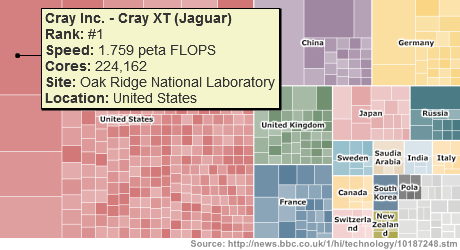US still the supercomputing superpower; Academia has major stake

As per the BBC News report yesterday, the bi-annual top 500 supercomputer list has been released and shows some interesting statistics. As a criminologist and a dyscalculiac, I need numbers but can barely read them at the same time. Nevertheless, these statistics show some interesting facts.

Information today is the new worldwide currency. This has been seen all over, with intelligence agencies fighting wars over intelligence, lives being lost for the sake of a prototype, and a worldwide network of intelligence gatherers working against their own governments. Information is priceless, and the ability to number crunch at the end of the day will be the nation's way of 'comparing sizes' at the global urinal.
- The fastest supercomputer in the world is the Cray XT Jaguar, with nearly 230,000 cores and with maximum running speeds of 1.759 peta-flops, based at the Oak Ridge National Laboratory in the United States.
- Around 92% of the top 500 supercomputers run Linux, with around 6% running AIX, 2% on Windows HPC and 1% on Open Solaris.
- The fastest university and academia machine is the Cray XT (an older version of the current fastest) running at the University of Tennessee, with nearly 99,000 cores and capable of 831 tera-flops. This is ranked at fourth in the world.
- With the broad range of logistics, finance, information services, government deference, weather and climate research, energy, retail, software and a good portion of classified uses, the two major uses by application are from supercomputing research and the field of academia.
- Academia takes up nearly 25% of all supercomputers, and mostly installed at university campuses around the world - some in the UK, the US and Europe. It is clear that academia is still a major area for supercomputing to use to really work out those niggling questions even as far back as Beccaria, Bentham and maybe Hobbes himself.
- Intel takes up the vast majority of processors by over half, with AMD slightly in front of IBM. Whereas, IBM manufacturers the most supercomputers, granted. But the most powerful and probably will be for a good while, Cray Inc. has this covered.
This shows beyond the fact that the US is really storming the world with its supercomputing technology, especially in weather prediction, environmental research and governmentally controlled and run systems which maintain defense and suchlike.
It shows in my eyes how wide the supercomputer use is yielding results like we have never seen in the academic community. Nobody gets answers like universities and to provide these institutions with these technologies also spurs on the development of students. Access levels will probably be restricted to undergraduate students, but nevertheless the technology is there and will be a full-frontal assault on developing the knowledge that we have yet to get.